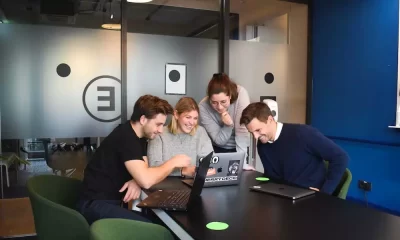Management
The Impact of Office Design on Company Identity

Creating an effective office space that successfully communicates your brand is one of the most important things you can do as a company. Every business will have a different corporate culture and specific needs that business owners should keep in mind. Capturing the message of your brand and creating a good impression is essential for your reputation and revenue.
It’s important to regularly assess your space and make sure your current office accurately represents your company identity to clients and employees alike. This is important in all industries, not just ones requiring regular visits from clients (or potential clients). For your business to be as successful as possible, you also need to recruit and retain top-notch candidates, and a well-designed office that clearly and originally reflects your office brand can do that.
Internal Branding
Organisations that give employees a safe, comfortable and stimulating environment to work in are seen to value their employees concretely.
By investing in staff not only improve productivity but also improve brand loyalty. It follows that employees who feel proud of their environment tend to value their organisation more. They are also more likely to display professionalism, put more energy into becoming an informal brand ambassador, and represent their company positively.
Boosting brand perception starts with using the same colours and logos in office decor, but then it goes much deeper. Offices are now showpieces for the company’s culture, and you can learn a lot from the layout design. For example, open workspaces emphasise a company’s interest in collaboration and communication. The recent trend towards integrated technology shows that a company is cutting-edge and moves with the times. Glass walls and partitions reflect a transparent culture, and art installations show an organisation’s attempt to add personality to their working environment.
Companies can use originality to make art or decor specific to their brand and achievements. For example, Angel Trains chose to have an open reception area connected to the meeting suites and hospitality area when the company relocated to Victoria Street in London. In addition, an American black walnut curved panel was installed with pigeon holes displaying models of the train carriages built by Angel Trains.
Similarly, the advertising group Dentsu wanted their West End office interior to reflect their mission statement “Making future magic” and their futuristic exterior, so it was designed with the “wow” factor. This includes specially commissioned features, such as a 10-metre long walkway entrance made out of sail fabric and a bespoke table in the style of an aeroplane wing in the penthouse suite boardroom. Staff at Dentsu are now blogging about how proud they are working in such an innovative space.
Brand Perception
As well as creating an inclusive atmosphere where staff feel at home, companies should stamp their personality on their business so that it ‘speaks’ to prospects the moment they enter. Office design that includes your logo, colours and style is part of the experience, but effectively connecting your brand with your mission and culture is much more than that.
It sounds obvious, but plenty of companies overlook this aspect of design. For example, if you want to leverage a perception of openness and communication, don’t have visitors walk into a sea of cubicles and separate offices. If you want to create an innovative environment, make sure the fixtures and fittings are contemporary and original somehow.
Bristol-based EMO & TRA have many corporate clients, so it was essential to create an attractive office space that inspired trust and collaboration from visitors. The open-plan offices fitted with bright colours, glass-walled offices, modern ergonomic furniture and public collaboration areas for staff create a great first impression.
Using design to express your company identity in your physical space, you can dramatically improve the way you are perceived by employees, clients and investors. Office design is a fundamental component of creating a positive office culture, attracting top talent, increasing productivity and generating a return on investment.






